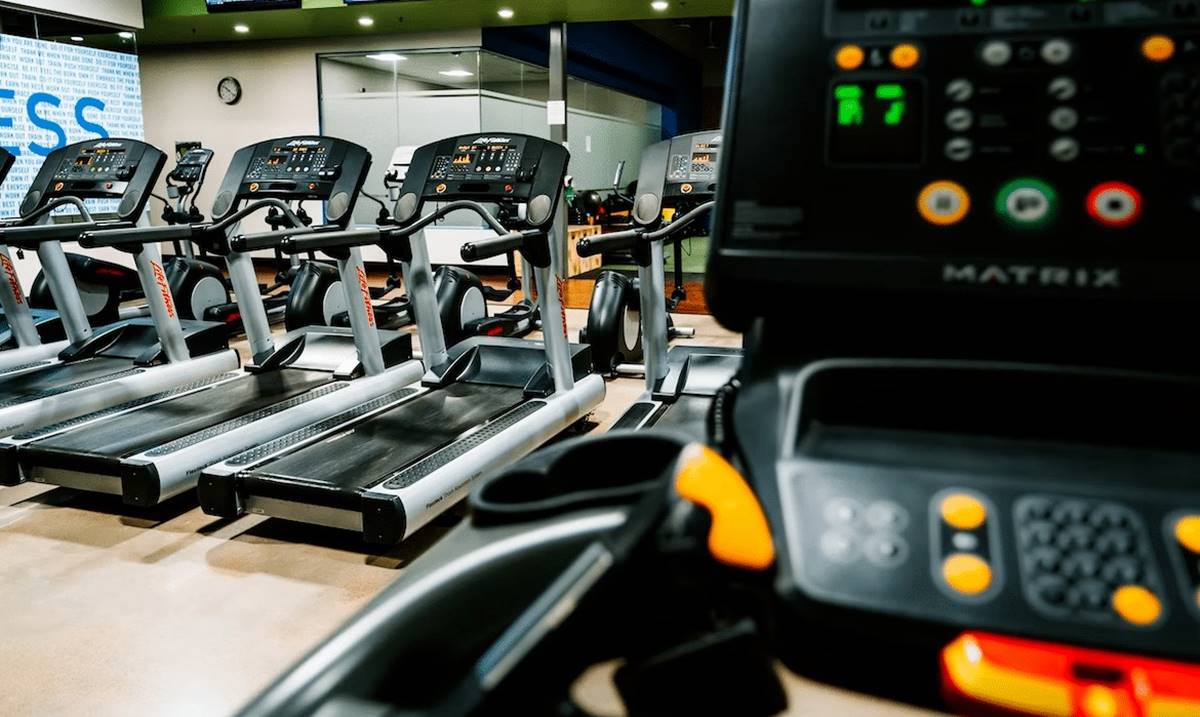

Featured
How To Do Jogging
Modified: August 21, 2023
Learn the featured techniques and tips on how to do jogging effectively for better fitness and health. Start your jogging journey today!
Introduction
Welcome to the wonderful world of jogging! Whether you’re a seasoned runner looking to switch up your routine or a beginner searching for a fun and effective way to get fit, jogging is a fantastic choice. It’s a versatile activity that can be enjoyed by people of all ages and fitness levels.
Jogging is more than just a form of exercise; it’s a lifestyle. It offers a multitude of physical and mental benefits that can transform your overall well-being. From improved cardiovascular health to stress reduction, jogging has the power to enhance your life in numerous ways.
In this comprehensive guide, we will delve into the world of jogging and equip you with all the knowledge and tools you need to embark on this exciting journey. Whether you’re a complete novice or looking to fine-tune your technique, this article will provide valuable insights.
So, grab your running shoes, put on some comfortable athletic gear, and get ready to hit the pavement. In the following sections, we will explore the benefits of jogging, discuss proper technique and form, and provide tips on how to stay motivated and avoid common mistakes. By the end, you’ll be well-equipped to start your jogging adventure and enjoy the countless advantages it brings.
But first, let’s dive into the amazing benefits that await you on the jogging path.
Benefits of Jogging
Jogging is not just a great way to improve your physical fitness; it also offers a wide range of benefits for your overall well-being. From boosting your cardiovascular health to enhancing your mental clarity, here are some of the incredible advantages of incorporating jogging into your routine.
- Improved Cardiovascular Health: Jogging is a fantastic aerobic exercise that elevates your heart rate, increasing blood circulation and improving the health of your cardiovascular system. Regular jogging can lower the risk of heart disease, strengthen your heart muscles, and improve overall cardiovascular endurance.
- Weight Management: Engaging in regular jogging can help you shed unwanted pounds and maintain a healthy weight. Jogging is a high-impact exercise that burns a significant amount of calories, making it an effective way to burn fat and tone your muscles.
- Increased Stamina and Endurance: As you gradually increase your jogging distance and pace, you will notice a significant improvement in your stamina and endurance. This increased endurance will not only benefit your running performance but also translate into everyday activities, allowing you to tackle physical tasks with greater ease.
- Stress Reduction: Jogging is a powerful stress reliever. When you jog, your body releases endorphins, also known as the “feel-good” hormones, which help reduce stress, anxiety, and depression. It’s a fantastic way to clear your mind, boost your mood, and find inner calmness.
- Improved Mental Clarity and Focus: Jogging is not only beneficial for your physical health but also for your mental well-being. It can improve cognitive function, enhance memory, and increase focus and concentration. Many people find that jogging provides them with a sense of mental clarity and helps them think more creatively.
- Boosted Immune System: Regular jogging can strengthen your immune system, making you more resistant to common illnesses such as colds and flu. Engaging in moderate-intensity exercise, like jogging, helps stimulate the production of white blood cells, antibodies, and other defense mechanisms that support a healthy immune system.
- Improved Sleep: Jogging can help regulate your sleep patterns and improve the quality of your sleep. By reducing stress, increasing physical activity, and promoting relaxation, jogging can help you fall asleep faster and enjoy a more restful night’s sleep.
These are just a few of the many benefits that jogging has to offer. Whether you’re looking to improve your physical fitness, manage your weight, relieve stress, or boost your mental well-being, jogging is a remarkable activity that can transform your life in numerous ways.
Getting Started
Starting a jogging routine doesn’t have to be intimidating. With the right approach and mindset, you can ease into it and begin reaping the benefits of this enjoyable form of exercise. Here are some steps to help you get started on your jogging journey:
- Consult with your healthcare professional: Before starting any new exercise routine, it’s always a good idea to consult with your healthcare professional, especially if you have any underlying medical conditions or concerns.
- Invest in proper running shoes: One of the most important investments you can make when starting jogging is a pair of good quality running shoes that provide proper support and cushioning. Visit a specialty running store to get expert advice on selecting the right shoes for your foot type and running style.
- Start slow and gradually increase: When beginning your jogging journey, start with a combination of walking and jogging intervals. This will help your body adjust to the new demands and reduce the risk of injury. As your fitness level improves, gradually increase the duration and intensity of your jogging segments.
- Find a suitable location: Choose a safe and scenic location for your jogging sessions. This could be a local park, trail, or even your neighborhood streets. Make sure the terrain is suitable for running and consider the availability of water fountains or facilities if needed.
- Establish a regular schedule: Consistency is key when it comes to jogging. Establish a regular schedule that works for you, whether it’s early mornings, evenings, or lunch breaks. By making jogging a regular part of your routine, you’re more likely to stick with it and make progress.
- Listen to your body: Pay attention to how your body feels during and after each jogging session. It’s normal to experience some muscle soreness in the beginning, but if you feel any sharp or persistent pain, it’s important to take a break and seek professional advice if needed.
- Track your progress: Keep a record of your jogging distance, time, and how you feel after each session. This will not only help you track your progress but also serve as motivation to see how far you’ve come.
- Enjoy the journey: Remember, jogging is not just about reaching a destination; it’s about enjoying the process. Embrace the beauty of nature, listen to energizing music or podcasts, or invite a friend to join you on your jogging adventures. Make it a joyful experience that you look forward to.
With these steps in mind, you’re now equipped to begin your jogging journey. Start with small, manageable steps and gradually build upon them. Soon enough, you’ll find yourself effortlessly jogging and reaping all the incredible benefits it has to offer.
Proper Technique and Form
Having the correct technique and form is essential for efficient and injury-free jogging. Follow these guidelines to ensure you’re maintaining proper form throughout your runs:
- Posture: Keep your head up, looking forward, and your shoulders relaxed. Avoid slouching or leaning too far forward or backward. Engage your core muscles to maintain a stable and upright posture.
- Arm Movement: Bend your elbows at a 90-degree angle and allow your arms to swing naturally back and forth, at your sides. Your hands should be relaxed, with a slight clenched fist, but avoid tensing your shoulders or crossing your arms across your body.
- Footstrike: Aim for a midfoot or forefoot strike when your foot makes contact with the ground. Avoid landing on your heels, as it can lead to excessive impact and potential injuries. Focus on a gentle and smooth landing with each step.
- Cadence: Aim for a cadence of around 180 steps per minute, which means taking approximately three steps per second. This faster cadence helps reduce the force on your joints and can improve overall running efficiency.
- Breathing: Breathe deeply and rhythmically. Inhale through your nose and exhale through your mouth. Focus on a steady breathing pattern that matches your running pace.
- Stride Length: Avoid overstriding, which is taking long strides that require excessive energy and can increase the risk of injury. Instead, focus on shorter, quicker strides that maintain an efficient and balanced running motion.
- Listen to your body: Pay attention to any signs of discomfort or pain while jogging. If you feel any unusual sensations, adjust your form or take a break to avoid pushing through potential injuries.
- Gradual Progression: Slowly and gradually increase the intensity, duration, and distance of your jogging sessions. This allows your body to adapt and reduces the risk of overuse injuries.
Remember, practice makes perfect when it comes to form and technique. Be patient with yourself as you develop and refine your jogging skills. By focusing on maintaining proper posture, arm movement, footstrike, and breathing, you’ll not only improve your running efficiency but also reduce the risk of injury.
Now that you’re equipped with the knowledge of proper technique and form, let’s move on to another crucial aspect of jogging – selecting the right shoes.
Choosing the Right Shoes
Choosing the right shoes is paramount to your jogging experience. The right pair of shoes will provide the necessary support, cushioning, and stability to keep you comfortable and injury-free throughout your runs. Here are some tips for selecting the perfect jogging shoes:
- Get fitted by a professional: Visit a specialty running store to get fitted properly by an expert. They will assess your foot type, arches, and running gait to recommend the best shoe options for you.
- Consider your foot type: Different shoes are designed for different foot types. There are three main types: neutral, overpronation, and supination. Understanding your foot type will help you choose the appropriate shoe with the right amount of stability and support.
- Try them on: When trying on jogging shoes, make sure to wear the same type of socks you plan to wear during your runs. Walk or jog around the store to get a feel for the shoes and check for any discomfort or pressure points.
- Check for proper fit: Ensure that there is about a thumb’s width of space between your longest toe and the front of the shoe. The shoe should provide a snug but not tight fit, with ample room for your toes to move and wiggle comfortably.
- Consider cushioning and support: The amount of cushioning and support you need depends on your body weight, running style, and personal preference. Some runners prefer more cushioning for impact absorption, while others prefer a more responsive feel. Find what works best for you.
- Replace worn-out shoes: Keep track of the mileage on your shoes and replace them regularly. A general guideline is to replace your jogging shoes every 300-500 miles or every 6-12 months, depending on your usage and the wear and tear.
- Listen to your feet: Pay attention to any discomfort or pain in your feet while running. If you experience recurring problems, such as blisters, hot spots, or arch pain, it could be a sign that your shoes are not the right fit for you.
Investing in a quality pair of jogging shoes that are well-suited for your feet and running style is crucial for a comfortable and enjoyable jogging experience. Take the time to find the right shoes, and your feet will thank you for it!
Now that you’re equipped with the knowledge of proper shoe selection, let’s move on to preparing your body for a jogging session with warm-up and stretching exercises.
Warm-Up and Stretching
Before you begin your jogging session, it’s essential to properly warm up your body and perform stretching exercises. Warming up prepares your muscles and joints for the upcoming activity, while stretching helps improve flexibility and reduce the risk of injury. Follow these guidelines for an effective warm-up and stretching routine:
- Start with a light aerobic activity: Begin your warm-up with a few minutes of light aerobic exercise, such as brisk walking, slow jogging, or jumping jacks. This helps increase your heart rate and blood flow, getting your body ready for more intense activity.
- Dynamic stretches: Perform a series of dynamic stretches that target the major muscles used in jogging. Dynamic stretches involve moving parts of your body through a full range of motion, without holding the stretch. Examples include leg swings, arm circles, walking lunges, and high knees. These stretches help improve flexibility and mobility while activating your muscles.
- Focus on the major muscle groups: Pay attention to stretching the muscles that are most engaged during jogging, such as the calves, hamstrings, quadriceps, glutes, and hip flexors. Hold each stretch for 15-30 seconds, feeling a gentle pull but not to the point of pain. Remember to breathe deeply and relax into each stretch.
- Avoid bouncing or jerking: When performing static stretches (stretching while holding a position), avoid bouncing or jerking, as it can strain your muscles. Instead, aim for smooth, controlled movements and gradually deepen the stretch as your muscles loosen up.
- Include upper body stretches: Don’t forget to stretch your upper body as well. Stretch your arms, shoulders, and chest by performing exercises like arm crossovers, triceps stretches, and chest openers. This helps to improve posture and arm swing while jogging.
- Listen to your body: Pay attention to any discomfort or pain during stretching. If a stretch feels too intense or causes sharp pain, ease off or modify the stretch to a more comfortable position. It’s essential to stretch within your own limits and avoid pushing yourself too far.
By incorporating a warm-up and stretching routine into your jogging sessions, you prepare your body for the physical demands of running and reduce the risk of potential injuries. Remember, warming up and stretching should be an integral part of your jogging routine, just as important as the actual running itself.
Now that you’re warmed up and ready to go, let’s move on to creating a jogging routine that suits your fitness goals and preferences.
Creating a Jogging Routine
Creating a jogging routine is an essential step in achieving your fitness goals and making jogging a consistent part of your lifestyle. Here are some tips to help you establish a jogging routine that works for you:
- Set realistic goals: Start by setting realistic and achievable goals for your jogging routine. Whether it’s increasing your overall running distance, improving your pace, or jogging a certain number of times per week, having specific goals gives you something to work towards and helps keep you motivated.
- Determine your schedule: Decide on the days and times that you can dedicate to jogging. Choose a schedule that fits well with your other commitments and allows you to stay consistent. Block off these time slots in your calendar as non-negotiable jogging sessions.
- Gradual progression: When starting a jogging routine, it’s important to progress gradually to avoid overexertion and injuries. Begin with shorter distances or durations and gradually increase the intensity, distance, or duration of your runs over time. Listen to your body and take rest days as needed.
- Mix up your workouts: To keep your jogging routine enjoyable and prevent boredom, mix up your workouts. Incorporate different types of runs, such as intervals, tempo runs, hill workouts, or easy recovery runs. This variety challenges your body and keeps you engaged.
- Include cross-training: Supplement your jogging routine with other forms of exercise, such as strength training, cycling, swimming, or yoga. Cross-training helps improve overall fitness, prevents imbalances, and reduces the risk of overuse injuries.
- Consider joining a running group or club: Running with others can provide motivation, accountability, and a sense of community. Look for local running groups or clubs in your area where you can connect with like-minded individuals and share your jogging journey.
- Track your progress: Keep a log of your runs, noting the distance, duration, and any other relevant details. Tracking your progress helps you see how far you’ve come and provides a sense of accomplishment. There are various running apps and devices available that can help you monitor your runs and track your progress.
- Listen to your body: Pay attention to any signs of fatigue, soreness, or pain during and after your runs. It’s important to listen to your body and give yourself adequate rest and recovery time. Don’t hesitate to adjust your jogging routine or seek guidance from a healthcare professional if needed.
A well-planned jogging routine will not only keep you motivated but also help you make consistent progress and achieve your fitness goals. Find a routine that works for you, adapt as necessary, and always prioritize your safety and well-being.
Now let’s explore the importance of setting goals and tracking your progress in your jogging journey.
Setting Goals and Tracking Progress
Setting goals and tracking your progress is crucial for staying motivated and making continuous improvements in your jogging journey. By setting specific targets and monitoring your achievements, you can push yourself to reach new heights. Here’s how to effectively set goals and track your progress:
- Establish clear and realistic goals: Begin by defining your objectives. Whether it’s running a certain distance, improving your pace, or participating in a race, set goals that are challenging yet attainable. Make sure they align with your fitness level and timeframe.
- Break down your goals: Break down your long-term goals into smaller milestones. This allows you to focus on weekly or monthly targets, which are more manageable and provide a sense of accomplishment along the way.
- Use the SMART framework: Make your goals specific, measurable, achievable, relevant, and time-bound. For example, instead of saying, “I want to improve my pace,” set a goal like, “I want to decrease my mile time by 30 seconds within three months.”
- Track your runs: Keep a record of your running distances, times, and other relevant data. Use a running app, GPS watch, or a simple notebook to track your runs. This allows you to see your progress over time and identify areas for improvement.
- Celebrate milestones: Celebrate each milestone you achieve along the way. Whether it’s a new personal record, completing a challenging run, or reaching a specific distance, take the time to acknowledge and reward yourself. It reinforces your progress and motivates you to keep going.
- Stay accountable: Share your goals with a running buddy, join a running group, or use social media to hold yourself accountable. When others know about your goals, you’re more likely to stay committed and receive support and encouragement from others.
- Adjust and adapt: Be flexible and willing to adjust your goals as needed. Life can throw unexpected challenges, such as injuries or schedule changes. Modify your goals accordingly, whether it’s extending the timeline or adjusting the targets to reflect the new circumstances.
- Seek professional guidance: If you need guidance in setting realistic goals or tracking your progress effectively, consider consulting a running coach or a fitness professional. They can provide expert advice, personalized plans, and help you stay on track.
Remember, setting goals and tracking your progress not only adds structure to your jogging routine but also keeps you motivated and focused. Embrace the journey and enjoy the sense of accomplishment as you consistently work towards and achieve your goals.
Now, let’s explore some effective ways to stay motivated in your jogging practice.
Staying Motivated
Staying motivated is key to maintaining a consistent jogging routine. As with any form of exercise, there may be times when your motivation wanes. However, with the right strategies and mindset, you can keep your enthusiasm high and stay on track. Here are some effective ways to stay motivated in your jogging practice:
- Set meaningful goals: Having clear and meaningful goals gives you a sense of purpose and direction. Make sure your goals align with your personal values and aspirations. They should inspire you and remind you why you started jogging in the first place.
- Vary your routes and scenery: Exploring new routes and scenery can keep your jogging practice fresh and exciting. Discover local parks, trails, or scenic spots in your area to add a sense of adventure to your runs. Changing the scenery can make your runs more enjoyable and motivating.
- Join a running group or find an accountability buddy: Surrounding yourself with like-minded individuals can provide the support and motivation you need. Join a local running group, attend running events, or find an accountability buddy to share your goals and progress. The camaraderie and encouragement can be highly motivating.
- Reward yourself: Treat yourself when you achieve your goals or reach a milestone. It could be a new piece of running gear, a massage, or a relaxing self-care activity. The rewards act as a positive reinforcement and keep you excited about your progress.
- Track your progress visually: Use visual tools to track your progress. Create a mileage or goal tracker chart, use apps that display statistics and achievements, or even create a vision board with images that represent your running goals. Seeing your progress visually can be highly motivating.
- Listen to music or podcasts: Create a playlist of energizing songs or listen to podcasts that inspire and motivate you. Music and podcasts can provide a mental boost, distract you from fatigue, and enhance your overall running experience.
- Practice self-care: Taking care of yourself physically and mentally is crucial for staying motivated. Get enough sleep, eat nourishing foods, and incorporate rest days into your routine. When your body and mind are well-rested, you’ll have the energy and motivation to keep going.
- Celebrate small victories: Acknowledge and celebrate even the smallest achievements. Whether it’s completing a tough run, sticking to your schedule, or improving your pace, pat yourself on the back for your efforts. Celebrating small victories reinforces your progress and builds confidence.
- Visualize success: Visualize yourself achieving your jogging goals. Imagine how good it will feel to cross that finish line or improve your personal record. Visualization helps keep your goals at the forefront of your mind and motivates you to work towards them.
By incorporating these strategies into your jogging routine, you can maintain high levels of motivation and ensure your love for jogging endures. Remember, staying motivated is a gradual process, and it’s normal to have ups and downs. Keep experimenting with different techniques and find what works best for you.
Now, let’s explore some common mistakes to avoid when jogging to ensure a safe and enjoyable experience.
Avoiding Common Mistakes
Jogging is a fantastic form of exercise, but like any activity, there are common mistakes that can hinder your progress or lead to injuries. By being aware of these mistakes, you can ensure a safe and enjoyable jogging experience. Here are some common mistakes to avoid:
- Skipping warm-up and cool-down: Neglecting to warm up and cool down properly is a common mistake. Skipping these crucial routines can increase the risk of injury and leave you with sore muscles. Always make time for a proper warm-up before each jogging session and a cool-down afterward to gradually ease your body back to a resting state.
- Pushing yourself too hard, too soon: It’s important to build up your jogging gradually. Pushing yourself too hard, too soon can lead to overuse injuries, muscle strains, or burnout. Listen to your body, honor your limits, and progress at a pace that is comfortable for you.
- Not wearing the right shoes: Wearing improper or worn-out shoes is a recipe for foot and leg problems. Invest in a good pair of running shoes that offer proper support, cushioning, and comfort. Replace your shoes regularly to ensure they provide adequate protection and stability for your feet.
- Neglecting strength training: Many runners overlook the importance of strength training. Incorporating strength exercises into your routine helps build muscle, improve joint stability, and prevent injuries. Include exercises such as squats, lunges, planks, and core workouts in your training plan.
- Ignoring rest and recovery: Rest and recovery are essential for allowing your body to repair and adapt to the demands of jogging. Not giving yourself enough rest can lead to fatigue, decreased performance, and increased risk of injuries. Schedule regular rest days and prioritize sleep and proper nutrition for optimal recovery.
- Running with improper form: Running with poor form can lead to inefficient movement patterns and increased stress on joints and muscles. Focus on maintaining good posture, proper arm swing, and a midfoot or forefoot strike. Consider consulting a running coach or watching instructional videos for guidance on proper running form.
- Not hydrating properly: Hydration is vital for performing at your best and avoiding dehydration. Drink water before, during, and after your runs, especially on hot and humid days. Carry a water bottle with you or plan your routes where water fountains are available.
- Forgetting to listen to your body: Your body provides valuable feedback. Ignoring signs of fatigue, pain, or discomfort can lead to overexertion and injuries. If something feels off, adjust your pace, take a break, or consult a healthcare professional if needed. Pay attention to your body and prioritize its wellbeing.
Avoiding these common mistakes will help you enjoy a safe and successful jogging journey. Remember, patience and consistency are key. Gradually incorporate good habits into your jogging routine and focus on sustainable, long-term progress.
Now that you’re aware of these mistakes, let’s explore some essential safety tips to ensure a secure jogging experience.
Safety Tips for Jogging
Jogging is a safe and enjoyable activity, but it’s important to prioritize safety to ensure a secure experience. By following these safety tips, you can minimize the risk of accidents and injuries while enjoying your jogging routine:
- Wear reflective gear: If you’re jogging during low-light conditions or at night, wear reflective clothing or accessories to make yourself visible to drivers and other pedestrians. This helps enhance your safety and reduces the risk of accidents.
- Choose well-lit and populated routes: Opt for routes that are well-lit, preferably with streetlights or well-illuminated pathways. Jogging in populated areas or well-traveled routes also adds an extra layer of safety by increasing the presence of other people around you.
- Carry identification: Always carry identification, such as an ID card or a wristband with emergency contact details. In case of an accident or a medical emergency, this information can be crucial for quick and efficient assistance.
- Stay aware of your surroundings: Be mindful of your surroundings and stay alert while jogging. Avoid wearing headphones at high volumes that may impair your ability to hear approaching vehicles, cyclists, or potential hazards.
- Follow traffic rules: When jogging on the road, always follow traffic rules and run against the flow of traffic. This helps you see oncoming vehicles and enables drivers to notice you more easily. Use crosswalks and pedestrian signals when crossing intersections.
- Stay hydrated: Drink enough water before, during, and after your runs to stay hydrated. Dehydration can impact your performance and increase the risk of heat-related illnesses. Carry a water bottle with you or plan your route near water fountains.
- Protect yourself from the sun: Apply sunscreen with an appropriate SPF level to protect your skin from harmful UV rays. Wear a lightweight, breathable hat and sunglasses to shield your face and eyes from the sun’s glare.
- Inform someone about your plans: Before heading out for a jog, inform a family member or friend about your route and estimated return time. This ensures that someone knows where you are in case of an emergency or if you unexpectedly need assistance.
- Trust your instincts: If you feel uncomfortable or sense potential danger during your jog, trust your instincts. Alter your route, seek a more populated area, or ask for help if needed. Your safety should always be your top priority.
- Carry a phone or a personal safety device: Consider carrying a fully charged mobile phone or a personal safety device that allows you to call for help in case of an emergency. It’s a good precautionary measure to have a means of communication readily available at all times.
By following these safety tips, you can create a secure environment for your jogging sessions and enjoy peace of mind while focusing on improving your fitness and overall well-being.
Now, let’s conclude our comprehensive guide to jogging and reflect on the incredible benefits and possibilities that await you on your jogging journey.
Conclusion
Congratulations! You have now acquired a comprehensive understanding of the world of jogging. From the multitude of physical and mental benefits to the proper technique, choosing the right shoes, warming up, and creating a jogging routine, you are well-equipped to embark on a fulfilling jogging journey.
By incorporating jogging into your lifestyle, you can improve your cardiovascular health, manage your weight, reduce stress, increase stamina, and experience a boost in mental clarity and focus. Jogging is not only an activity that strengthens your body, but also enhances your overall well-being.
Remember to start your jogging routine gently, gradually increasing your pace and distance as your fitness level progresses. Proper technique and form are vital to prevent injuries and ensure an efficient running motion. Additionally, selecting the right shoes that offer proper support and cushioning is essential for a enjoyable and injury-free experience.
Don’t forget to warm up before each jog and incorporate stretching exercises to prepare your body and reduce the risk of injury. Set realistic goals, track your progress, and stay motivated by varying routes, joining running groups, and rewarding yourself along the way.
Ensuring safety is paramount during your jogging sessions. Wear reflective gear, choose well-lit routes, follow traffic rules, stay hydrated, and stay aware of your surroundings. Trust your instincts and take precautions to run in a secure environment.
Now, armed with all this knowledge and guidance, it’s time for you to lace up your running shoes, step outside, and embrace the unbeatable feeling of the wind on your face and the rhythm of your feet hitting the pavement. Jogging offers incredible physical, mental, and emotional rewards, and with consistency and dedication, you will undoubtedly experience the transformation it brings to your life.
So, go ahead, take that first step, and let jogging be your companion in your journey towards a healthier and happier you!









